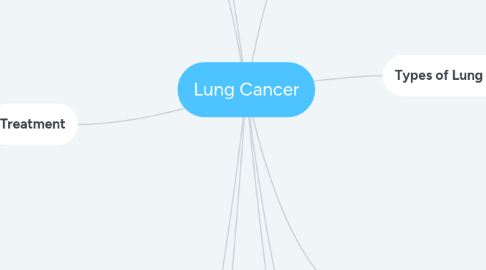
1. Symptoms
1.1. Cough, hemoptysis, sputum, chest wall pain, dyspnea, pleural effusion
1.2. Warning Signs: Persistent Cough, bloody sputum, chest pain, weight loss
2. Diagnostic Testing
2.1. Lung, Biopsy, bronchoscopy, electron microscopy, immunohistochemistry
2.2. Radiology: X-ray, CT scan, MRI
3. Treatment
3.1. Early stage lung carcinoma = surgical resection
3.1.1. VATS - Video-assisted thoracoscopic surgery (better mortality vs open lobectomy, 1% vs. 1.9%, respectively (Jones & Baldwin, 2018).
3.2. NSCLC = chemotherapy and radiation
3.2.1. Sterotactic Ablative radiotherapy (SABR) - deliver large dose or radiation with a high precision of 1-2 mm to small lesions (Jones & Baldwin, 2018).
3.2.1.1. 2-year Survival Rate, SABR 70% vs. Conventional radiotherapy 53%
3.2.2. Radiofrequency & Microwave ablation - sinusoidal current passes through lung lesion causing thermal destruction of cells (Jones & Baldwin, 2018).
3.2.3. Cisplatin - most effective against solid tumors
3.2.4. Taxanes
3.2.5. Paclitaxel - 1st-line chemotherapy treatment for NSCLC (Huang et al., 2017)
3.2.6. Chemotherapy has shown some benefit when used alone in patients with stage IV NSCLC. Platinum drugs are considered the most beneficial (Huang et al., 2017).
3.3. Pallative Care
3.3.1. concept in medical care that provides supportive care to those with life-threatening disease (Ferrell, Koczywas, Grannis, & Harrington, 2011)
3.3.2. "Aims at addressing the physical, psychological, spirtual, and practical burdens of illness" (Ferrell, Koczywas, Grannis, & Harrington, 2011)
3.3.3. Surgical and pharmacologic options
3.3.4. Interdisciplinary Team to plan care for both patient and family
3.3.5. Main goal is improving Quality of Life and preserving function (Ferrell, Koczywas, Grannis, & Harrington, 2011).
4. Genetic Suspectibility
4.1. Presence of a highly penetrant autosomal gene (Miller, 2005).
4.2. Locus on chromosome 6q23-25 was reported as lung cancer susceptibility among families (Miller, 2005).
4.3. CYP1A1 polymorphisms is the strongest possible genetic link (Miller, 2005).
4.4. Inherited susceptibility for developing addiction to nicotine is most important genetic determinant of lung cancer development (Miller, 2005).
4.5. Chromosome 3p Deletion - common in SCLC (Miller, 2005).
4.6. Rb and p53 tumor suppressors were shown to be universally inactivated in SCLC (Miller, 2005).
5. Lung cancer screening
5.1. Target those as high risk
5.1.1. Family history
5.1.2. Smokers
5.1.3. older age
5.1.4. lower socioeconomic status
5.2. Mobile CT scanners
5.2.1. Low-dose CT screening
5.3. Chest X-ray screening & sputum cytology
5.4. Liquid biopsies - use of blood-borne biomarkers (Knight et al., 2017).
6. Risk Factors
6.1. #1 Cigarette Smoke - accounts for 80% of all lung cancers deaths (Huether, 2019)
6.1.1. Environmental exposure (2nd hand smoke)
6.2. Occupational Factors
6.2.1. 1) Asbestos dust
6.2.2. 2) Arsenic
6.2.3. 3) ionizing radiation
6.2.4. 4) coal products
6.2.5. 5) mustard gas
7. Types of Lung Cancer
7.1. 1) Nonsmall Cell Lung Carcinoma (85% of all lung cancers)
7.1.1. 1) Squamous Cell Carcinoma - slow, metastasizes late to hilar lymph nodes
7.1.2. 2) Adenocarcinoma - moderate growth rate, early metastasis to lymph nodes, bone, adrenal gland, and brain (Huether, 2019)
7.1.3. 3) Large Cell Carcinoma - rapid growth rate, early and widespread metastasis
7.2. 2) Nueroendocrine Tumors
7.2.1. 1) Small Cell Carcinoma - very rapid growth, very early metastasis to mediastinum, lymph nodes, brain, and bone marrow (Huether, 2019)
7.2.1.1. Strongest correlation to Smoking
8. Pathophysiology
8.1. Biology of early lung cancer
8.1.1. Cells responsible for airway repair as the initiating cells of tumors in the lung (Blandin Knight et al., 2017)
8.1.2. Neuroendocrine Cells are the starters for SCLC (Blandin Knight et al., 2017)
8.1.3. Origin of Kras-driven adenocarcinomas is the alveolar type II epithelial cells (Blandin Knight et al., 2017)
8.2. 20% of Cancers are related to chronic inflammation, innate immune cells
8.2.1. Tumor microenvironment coordinates pro-inflammatory responses through both inflammatory cells as well as cytokines, chemokines, and prostaglandins
9. Statistics
9.1. 1) Lung cancer is the leading cause of cancer-related death in the world (Blandin Knight et al., 2017).
9.2. 2) 155,870 deaths in the United States in 2017
10. TNM Classification System
10.1. T denotes primary tumor
10.2. N indicates nodal involvement
10.3. M is extent of metastasis
10.4. Increase accuracy of staging for lung cancer
10.4.1. PET-CT = Positron emission tomography
10.4.2. EBUS = Endobronchial ultrasound

